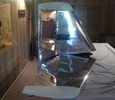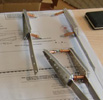


random user submitted photo
Sonex High Wing
26 posts
• Page 3 of 3 • 1, 2, 3
Re: Sonex High Wing
Bryan Cotton wrote:BRS wrote:WaiexB22 wrote: The high wing is the same, but you do lose the unobstructed view through the bubble canopy.
Yup, After flying under a bubble canopy, all high wing aircraft are pretty claustrophobic.
- flyguy0609
- Posts: 46
- Joined: Tue Aug 03, 2021 12:17 pm
Re: Sonex High Wing
High Wing/Low Wing - In the end both have their benefits/disadvantages - in my view end up pretty equal. It all comes down to individual pilot preference.
Undercarriage;
My last aircraft had fibreglass main and rubber donut nose wheel suspension - great on grass.
My Legacy undercarriage is way to "whippy" on grass and the tailwheel makes channels (digs in) if the ground is slightly damp. Further the whippy main has little/no natural damping making any landing, less than perfect, into a bounce, with the presence of surface imperfections adding to the tendency. I would council Sonex to come up with an undercarriage option that is more accommodating of unsealed runways (common outside the USA). For the mains, something similar to the Onex might be the way to go and an option for a wider/larger diameter tailwheel tyre is a must.
Fuel Capacity;
Anyone know what this may be?
Australian pilots tend towards wanting good duration - fuel options often far apart.
Undercarriage;
My last aircraft had fibreglass main and rubber donut nose wheel suspension - great on grass.
My Legacy undercarriage is way to "whippy" on grass and the tailwheel makes channels (digs in) if the ground is slightly damp. Further the whippy main has little/no natural damping making any landing, less than perfect, into a bounce, with the presence of surface imperfections adding to the tendency. I would council Sonex to come up with an undercarriage option that is more accommodating of unsealed runways (common outside the USA). For the mains, something similar to the Onex might be the way to go and an option for a wider/larger diameter tailwheel tyre is a must.
Fuel Capacity;
Anyone know what this may be?
Australian pilots tend towards wanting good duration - fuel options often far apart.
- Skippydiesel
- Posts: 799
- Joined: Tue Jul 06, 2021 6:24 am
Re: Sonex High Wing
Skippydiesel wrote:
Fuel Capacity;
Anyone know what this may be?
Australian pilots tend towards wanting good duration - fuel options often far apart.
In the video mentioned, Mark Schiable says the high wing has a 20 gallon B model fuel tank, plus two 5 gallon aux tanks in the wing center section. These aux tanks have shutoffs so you gravity drain them into the main tank when you have space.
Bryan Cotton
Poplar Grove, IL C77
Waiex 191 N191YX
Taildragger, Aerovee, acro ailerons
dual sticks with sport trainer controls
Prebuilt spars and machined angle kit
Year 2 flying and approaching 200 hours December 23
Poplar Grove, IL C77
Waiex 191 N191YX
Taildragger, Aerovee, acro ailerons
dual sticks with sport trainer controls
Prebuilt spars and machined angle kit
Year 2 flying and approaching 200 hours December 23
-

Bryan Cotton - Posts: 5489
- Joined: Mon Jul 01, 2013 9:54 pm
- Location: C77
Re: Sonex High Wing
114L - NICE! - thats about 7.6 hrs duration (to empty) for a Rotax 912 ULS at economy cruise power.
Aussies might increase those wing tanks to 30L +/side for an all up fuel load of 136L giving 9 hr duration.
OR if wing space does not permit increasing the size of the fuselage header
OR installing an in fuselage auxiliary.
If its the B model tank - I hope they have done away with the fool of a fill point location/system.
Aussies might increase those wing tanks to 30L +/side for an all up fuel load of 136L giving 9 hr duration.
OR if wing space does not permit increasing the size of the fuselage header
OR installing an in fuselage auxiliary.
If its the B model tank - I hope they have done away with the fool of a fill point location/system.
- Skippydiesel
- Posts: 799
- Joined: Tue Jul 06, 2021 6:24 am
Re: Sonex High Wing
Skippydiesel wrote:OR if wing space does not permit increasing the size of the fuselage header
OR installing an in fuselage auxiliary.
If its the B model tank - I hope they have done away with the fool of a fill point location/system.
Wing space - you can see in one of the photos I posted in this thread about a week back looking at the top of the wing - the aux fuel tanks are in the wing center section that is integral w/ the fuselage. They did this so the fuel system could remain complete with the wing outer panels off for road transportation / long-term storage / reduced need for build space. Simplest place to add fuel capacity would be in the behind-seat baggage area, and they're currently presenting 90 lb (of weight capacity, not fuel weight) available there. Personally, I can't sit as long as the flight durations you're proposing, so if I wanted that sort of range extension, some self-contained fuel cans/bottles back there, land, top off, keep going would work for me rather than installing anything more permanent.
They did say they're using the B model tank - I can think of a couple reasons not least of which is reduced cost on their side having to carry different inventory at reduced quantities + amortizing supplier set-up costs for a new tank. You can see in one of my photos from the front the same fuel fill door surround feature as the B model in the windshield trim. It's maybe not the best in that if they go with polycarbonate windshield material (which I expect they would, as it can be a flat piece that wraps into place) the polycarbonate supposedly degrades if there's contact with fuel, but I never had an issue with my Sonex, even with the occasional drip. Just don't let fuel sit on there and it seems to do ok. Or if the windshield gets stained or something over time, it's just flat polycarbonate - not too expensive and very easy to cut and drill. You should be able to source it locally and not need to ship a windshield all the way from the factory.
Sonex 815, TD, dual stick (sold in 2013)
Jabiru 3300
Jabiru 3300
- Eric W
- Posts: 24
- Joined: Tue Aug 31, 2021 8:30 pm
- Location: KAVQ
Re: Sonex High Wing
Thanks Eric.
Fuel fill point -
My Sonex has wing tanks, that feed the centre/header tank (total capacity 100L). The only down side of this is, to put fuel in the header requires the transfer pump being switched on. This would be less of an issue with a high wing, as gravity will do the work automatically.
Fuel Capacity/Endurance -
Endurance for me is not about spending hours & hours in the air (I like to have a wee break/leg stretch about every 2-3 hrs) is about not worrying about where the next fuel is coming from ie having the duration to comfortably make it between refuelings, irrespective of the number of in-between stops.
It's far safer & convenient to have built in tanks, that you can transfer from in flight/on the ground, rather than carry bladders or jerry cans that must be hoisted in/out of the aircraft and then decanted into the fuel tank.
Fuel fill point -
My Sonex has wing tanks, that feed the centre/header tank (total capacity 100L). The only down side of this is, to put fuel in the header requires the transfer pump being switched on. This would be less of an issue with a high wing, as gravity will do the work automatically.
Fuel Capacity/Endurance -
Endurance for me is not about spending hours & hours in the air (I like to have a wee break/leg stretch about every 2-3 hrs) is about not worrying about where the next fuel is coming from ie having the duration to comfortably make it between refuelings, irrespective of the number of in-between stops.
It's far safer & convenient to have built in tanks, that you can transfer from in flight/on the ground, rather than carry bladders or jerry cans that must be hoisted in/out of the aircraft and then decanted into the fuel tank.
- Skippydiesel
- Posts: 799
- Joined: Tue Jul 06, 2021 6:24 am
26 posts
• Page 3 of 3 • 1, 2, 3
Who is online
Users browsing this forum: No registered users and 1 guest







